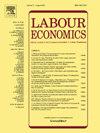Deunionization and skills
IF 2.6
2区 经济学
Q2 ECONOMICS
引用次数: 0
Abstract
A search and matching model is developed to investigate the effect of skill distribution change and skill-biased technical change (SBTC) on United States private sector unionization. The model’s equilibrium is such that workers with moderate skill will select into the union sector while those with low or high skill will select into the non-union sector. The model’s calibration to the U.S. private sector employs a novel method to separate movements in the skill distribution and skill premium. This, in turn, is used to help identify SBTC. A counterfactual analysis documents a significant relationship between the skill distribution and unionization. In particular, a rise in skill dispersion accounts for one-seventh of U.S. private sector deunionization between 1984 and 2019. This analysis also gives a quantitative effect of SBTC in line with the literature: it accounts for between one-fifth and two-fifths of deunionization depending on the specification. However, part of its qualitative effect is novel: SBTC shifts unionization towards more skilled workers. Further analysis suggests that skill distribution change is not likely to have a significant effect on private sector unionization in the future.
去工会化和技能
本文建立了一个搜索匹配模型来研究技能分布变化和技能偏向技术变化(SBTC)对美国私营部门工会化的影响。该模型的均衡是这样的,中等技能的工人将选择加入工会部门,而低技能或高技能的工人将选择加入非工会部门。该模型对美国私营部门的校准采用了一种新颖的方法来分离技能分布和技能溢价的运动。这反过来又用于帮助识别SBTC。一项反事实分析证明了技能分布与工会化之间的重要关系。特别是,在1984年至2019年期间,技能分散的增加占美国私营部门解散的七分之一。该分析还给出了与文献一致的SBTC的定量效应:根据规格,它占去unionization的五分之一到五分之二之间。然而,它的部分定性影响是新颖的:SBTC将工会组织转向更熟练的工人。进一步的分析表明,技能分配的变化不太可能在未来对私营部门的工会化产生重大影响。
本文章由计算机程序翻译,如有差异,请以英文原文为准。
求助全文
约1分钟内获得全文
求助全文
来源期刊

Labour Economics
ECONOMICS-
CiteScore
3.60
自引率
8.30%
发文量
142
期刊介绍:
Labour Economics is devoted to publishing research in the field of labour economics both on the microeconomic and on the macroeconomic level, in a balanced mix of theory, empirical testing and policy applications. It gives due recognition to analysis and explanation of institutional arrangements of national labour markets and the impact of these institutions on labour market outcomes.
 求助内容:
求助内容: 应助结果提醒方式:
应助结果提醒方式:


